Computer-Based Analysis of the Stochastic Stability of Mechanical Structures Driven by White and Colored Noise
Abstract
:1. Introduction
1.1. Background
1.2. Factors Effecting Fuel Efficiency
1.2.1. Vehicle Design Factors
1.2.2. Environmental Factors
1.3. Formulation of the Problem
1.3.1. Methods of Improving the Fuel Efficiency
1.3.2. Methods of Improving the Vehicle Suspension
1.4. Scope and Contribution
1.5. Organization of the Paper
2. Methodology
2.1. Fuel Consumption Model
2.2. Active Suspension Model
2.3. PID Controller
3. Results
4. Conclusions and Future Work
Funding
Conflicts of Interest
References
- Hoffert, M.I.; Caldeira, K.; Benford, G.; Criswell, D.R.; Green, C.; Herzog, H.; Jain, A.K.; Kheshgi, H.S.; Lackner, K.S.; Lewis, J.S.; et al. Advanced technology paths to global climate stability: Energy for a greenhouse planet. Science 2002, 298, 981–987. [Google Scholar] [CrossRef] [PubMed]
- Vitousek, P.M.; Mooney, H.A.; Lubchenco, J.; Melillo, J.M. Human domination of Earth’s ecosystems. Science 1997, 277, 494–499. [Google Scholar] [CrossRef]
- Dong, B.; Sutton, R.T.; Scaife, A.A. Multidecadal modulation of El Nino–Southern Oscillation (ENSO) variance by Atlantic Ocean sea surface temperatures. Geophys. Res. Lett. 2006, 33. [Google Scholar] [CrossRef]
- Younger, M.; Morrow-Almeida, H.R.; Vindigni, S.M.; Dannenberg, A.L. The built environment, climate change, and health: Opportunities for co-benefits. Am. J. Prev. Med. 2008, 35, 517–526. [Google Scholar] [CrossRef] [PubMed]
- Pacala, S.; Socolow, R. Stabilization wedges: Solving the climate problem for the next 50 years with current technologies. Science 2004, 305, 968–972. [Google Scholar] [CrossRef] [PubMed]
- Shafiee, S.; Topal, E. When will fossil fuel reserves be diminished? Energy Policy 2009, 37, 181–189. [Google Scholar] [CrossRef]
- Dincer, I. Renewable energy and sustainable development: A crucial review. Renew. Sustain. Energy Rev. 2000, 4, 157–175. [Google Scholar] [CrossRef]
- Small, K.A.; Van Dender, K. Fuel efficiency and motor vehicle travel: The declining rebound effect. Energy J. 2007, 28, 25–51. [Google Scholar] [CrossRef]
- Goldberg, P.K. The effects of the corporate average fuel efficiency standards in the US. J. Ind. Econ. 1998, 46, 1–33. [Google Scholar] [CrossRef]
- Stone, R. Motor Vehicle Fuel Economy; Macmillan International Higher Education: London, UK, 2017. [Google Scholar]
- Mock, P.; German, J.; Bandivadekar, A.; Riemersma, I. Discrepancies between Type-Approval and Real-World Fuel-Consumption and CO; The International Council on Clean Transportation: Washington, DC, USA, 2012; Volume 13. [Google Scholar]
- Kågeson, P. Reducing CO2 Emissions from New Cars; European Federation for Transport and Environment: Brussels, Belgium, 2005. [Google Scholar]
- McBeath, S. Competition Car Aerodynamics, 3rd ed.; Veloce Publishing Ltd.: Poundbury, UK, 2017. [Google Scholar]
- Holmberg, K.; Andersson, P.; Nylund, N.-O.; Mäkelä, K.; Erdemir, A. Global energy consumption due to friction in trucks and buses. Tribol. Int. 2014, 78, 94–114. [Google Scholar] [CrossRef]
- Liu, J.; Zheng, Z.; Li, F.; Lei, W.; Gao, Y.; Wu, Y.; Zhang, L.; Wang, Z.L. Nanoparticle chemically end-linking elastomer network with super-low hysteresis loss for fuel-saving automobile. Nano Energy 2016, 28, 87–96. [Google Scholar] [CrossRef] [Green Version]
- Kakaee, A.-H.; Rahnama, P.; Paykani, A. Influence of fuel composition on combustion and emissions characteristics of natural gas/diesel RCCI engine. J. Nat. Gas Sci. Eng. 2015, 25, 58–65. [Google Scholar] [CrossRef]
- Dicks, A.; Rand, D.A.J. Fuel Cell Systems Explained; Wiley Online Library: Hoboken, NJ, USA, 2018. [Google Scholar]
- Khalife, E.; Tabatabaei, M.; Demirbas, A.; Aghbashlo, M. Impacts of additives on performance and emission characteristics of diesel engines during steady state operation. Prog. Energy Combust. Sci. 2017, 59, 32–78. [Google Scholar] [CrossRef]
- Zhou, M.; Jin, H.; Wang, W. A review of vehicle fuel consumption models to evaluate eco-driving and eco-routing. Transp. Res. Part D Transp. Environ. 2016, 49, 203–218. [Google Scholar] [CrossRef]
- Flannigan, M.D.; Wotton, B.M.; Marshall, G.A.; De Groot, W.J.; Johnston, J.; Jurko, N.; Cantin, A.S. Fuel moisture sensitivity to temperature and precipitation: Climate change implications. Clim. Chang. 2016, 134, 59–71. [Google Scholar] [CrossRef]
- Xu, Y.; Gbologah, F.E.; Lee, D.-Y.; Liu, H.; Rodgers, M.O.; Guensler, R.L. Assessment of alternative fuel and powertrain transit bus options using real-world operations data: Life-cycle fuel and emissions modeling. Appl. Energy 2015, 154, 143–159. [Google Scholar] [CrossRef]
- Li, L.; You, S.; Yang, C.; Yan, B.; Song, J.; Chen, Z. Driving-behavior-aware stochastic model predictive control for plug-in hybrid electric buses. Appl. Energy 2016, 162, 868–879. [Google Scholar] [CrossRef]
- Wang, H.; Zhang, X.; Ouyang, M. Energy consumption of electric vehicles based on real-world driving patterns: A case study of Beijing. Appl. Energy 2015, 157, 710–719. [Google Scholar] [CrossRef]
- Li, S.E.; Peng, H. Strategies to minimize the fuel consumption of passenger cars during car-following scenarios. Proc. Inst. Mech. Eng. Part D J. Automob. Eng. 2012, 226, 419–429. [Google Scholar] [CrossRef]
- DeRaad, L. The Influence of Road Surface Texture on Tire Rolling Resistance; SAE Technical Paper 780257; SAE International: Warrendale, PA, USA, 1978. [Google Scholar]
- Descornet, G. Road-surface influence on tire rolling resistance. In Surface Characteristics of Roadways: International Research and Technologies; ASTM International: West Conshohocken, PA, USA, 1990. [Google Scholar]
- Sandberg, U.; Bergiers, A.; Ejsmont, J.A.; Goubert, L.; Karlsson, R.; Zöller, M. Road Surface Influence on Tyre/Road Rolling Resistance; Swedish Road and Transport Research Institute (VTI): Linköping, Sweden, 2011. [Google Scholar]
- Zaabar, I.; Chatti, K. A Field Investigation of the Effect of Pavement Surface Conditions on Fuel Consumption. In Proceedings of the Transportation Research Board 90th Annual Meeting, Washington, DC, USA, 23–27 January 2011. [Google Scholar]
- Perrotta, F.; Trupia, L.; Parry, T.; Neves, L.C. Route level analysis of road pavement surface condition and truck fleet fuel consumption. In Pavement Life-Cycle Assessment; CRC Press: Boca Raton, FL, USA, 2017; pp. 61–68. [Google Scholar]
- Dhakal, N.; Elseifi, M.A. Effects of Asphalt-Mixture Characteristics and Vehicle Speed on Fuel-Consumption Excess Using Finite-Element Modeling. J. Transp. Eng. Part A Syst. 2017, 143, 04017047. [Google Scholar] [CrossRef]
- Ziyadi, M.; Ozer, H.; Kang, S.; Al-Qadi, I.L. Vehicle energy consumption and an environmental impact calculation model for the transportation infrastructure systems. J. Clean. Prod. 2018, 174, 424–436. [Google Scholar] [CrossRef]
- Loulizi, A.; Rakha, H.; Bichiou, Y. Quantifying grade effects on vehicle fuel consumption for use in sustainable highway design. Int. J. Sustain. Transp. 2018, 12, 441–451. [Google Scholar] [CrossRef]
- Huang, Y.; Ng, E.C.; Zhou, J.L.; Surawski, N.C.; Chan, E.F.; Hong, G. Eco-driving technology for sustainable road transport: A review. Renew. Sustain. Energy Rev. 2018, 93, 596–609. [Google Scholar] [CrossRef]
- Speckert, M.; Lübke, M.; Wagner, B.; Anstötz, T.; Haupt, C. Representative Road Selection and Route Planning for Commercial Vehicle Development. In Commercial Vehicle Technology 2018; Springer: Berlin, Germany, 2018; pp. 117–128. [Google Scholar]
- Pérez-Zuriaga, A.M.; Llopis-Castelló, D.; Camacho-Torregrosa, F.J.; Belkacem, I.; García, A. Impact of Horizontal Geometric Design of Two-Lane Rural Roads on Vehicle CO2 Emissions. In Proceedings of the Transportation Research Board 96th Annual Meeting, Washington, DC, USA, 8–12 January 2017. [Google Scholar]
- Liu, L.; Li, C.; Hua, X.; Li, Y. Multi-factor integration based eco-driving optimization of vehicles with same driving characteristics. In Proceedings of the Chinese Automation Congress (CAC), Jinan, China, 20–22 October 2017; pp. 6871–6876. [Google Scholar]
- Palmer, J.; Sljivar, S. Vehicle Fuel Consumption Monitor and Feedback Systems. U.S. Patent 9,610,955, 4 April 2017. Available online: https://patentimages.storage.googleapis.com/c6/b7/c5/3871b4cea3e583/EP2878509A3.pdf (accessed on 25 September 2018).
- Alvarado, P.J. Steel vs. Plastics: The competition for light-vehicle fuel tanks. JOM 1996, 48, 22–25. [Google Scholar] [CrossRef]
- Kurihara, Y.; Nakazawa, K.; Ohashi, K.; Momoo, S.; Numazaki, K. Development of multi-layer plastic fuel tanks for Nissan research vehicle-II. SAE Trans. 1987, 96, 1239–1245. [Google Scholar]
- Bahng, G.; Jang, D.; Kim, Y.; Shin, M. A new technology to overcome the limits of HCCI engine through fuel modification. Appl. Therm. Eng. 2016, 98, 810–815. [Google Scholar] [CrossRef]
- Erkuş, B.; Karamangil, M.I.; Sürmen, A. Enhancing the heavy load performance of a gasoline engine converted for LPG use by modifying the ignition timings. Appl. Therm. Eng. 2015, 85, 188–194. [Google Scholar] [CrossRef]
- Tangöz, S.; Akansu, S.O.; Kahraman, N.; Malkoc, Y. Effects of compression ratio on performance and emissions of a modified diesel engine fueled by HCNG. Int. J. Hydrog. Energy 2015, 40, 15374–15380. [Google Scholar] [CrossRef]
- Ben-Chaim, M.; Shmerling, E.; Kuperman, A. Analytic modeling of vehicle fuel consumption. Energies 2013, 6, 117–127. [Google Scholar] [CrossRef]
- Ahn, K. Microscopic Fuel Consumption and Emission Modeling. Ph.D. Thesis, Virginia Tech, Blacksburg, VA, USA, 1998. [Google Scholar]
- Ross, M. Automobile fuel consumption and emissions: Effects of vehicle and driving characteristics. Annu. Rev. Energy Environ. 1994, 19, 75–112. [Google Scholar] [CrossRef]
- Smit, R.; Brown, A.; Chan, Y. Do air pollution emissions and fuel consumption models for roadways include the effects of congestion in the roadway traffic flow? Environ. Model. Softw. 2008, 23, 1262–1270. [Google Scholar] [CrossRef]
- Rakha, H.A.; Ahn, K.; Moran, K.; Saerens, B.; van den Bulck, E. Virginia tech comprehensive power-based fuel consumption model: Model development and testing. Transp. Res. Part D Transp. Environ. 2011, 16, 492–503. [Google Scholar] [CrossRef]
- Tang, T.-Q.; Huang, H.-J.; Shang, H.-Y. Influences of the driver’s bounded rationality on micro driving behavior, fuel consumption and emissions. Transp. Res. Part D Transp. Environ. 2015, 41, 423–432. [Google Scholar] [CrossRef]
- Wang, J.; Rakha, H.A. Fuel consumption model for heavy duty diesel trucks: Model development and testing. Transp. Res. Part D Transp. Environ. 2017, 55, 127–141. [Google Scholar] [CrossRef]
- Wang, Y.; Zhao, W.; Zhou, G.; Gao, Q.; Wang, C. Suspension mechanical performance and vehicle ride comfort applying a novel jounce bumper based on negative Poisson’s ratio structure. Adv. Eng. Softw. 2018, 122, 1–12. [Google Scholar] [CrossRef]
- Ren, W.; Peng, B.; Shen, J.; Li, Y.; Yu, Y. Study on Vibration Characteristics and Human Riding Comfort of a Special Equipment Cab. J. Sens. 2018, 2018, 7140610. [Google Scholar] [CrossRef]
- Koganti, P.B.; Udwadia, F.E. Unified approach to modeling and control of rigid multibody systems. J. Guid. Control Dyn. 2016, 39, 2683–2698. [Google Scholar] [CrossRef]
- Pappalardo, C.M.; Guida, D. Control of nonlinear vibrations using the adjoint method. Meccanica 2017, 52, 2503–2526. [Google Scholar] [CrossRef]
- Pappalardo, C.M.; Guida, D. Use of the Adjoint Method for Controlling the Mechanical Vibrations of Nonlinear Systems. Machines 2018, 6, 19. [Google Scholar] [CrossRef]
- Huang, Y.; Na, J.; Wu, X.; Liu, X.; Guo, Y. Adaptive control of nonlinear uncertain active suspension systems with prescribed performance. ISA Trans. 2015, 54, 145–155. [Google Scholar] [CrossRef] [PubMed]
- Zhu, Q.; Ding, J.-J.; Yang, M.-L. LQG control based lateral active secondary and primary suspensions of high-speed train for ride quality and hunting stability. IET Control Theory Appl. 2018, 12, 1497–1504. [Google Scholar] [CrossRef]
- Marzbanrad, J.; Zahabi, N. H∞ active control of a vehicle suspension system exited by harmonic and random roads. Mech. Mech. Eng. 2017, 21, 171–180. [Google Scholar]
- Elmadany, M.M. Optimal linear active suspensions with multivariable integral control. Veh. Syst. Dyn. 1990, 19, 313–329. [Google Scholar] [CrossRef]
- Siswoyo, H.; Mir-Nasiri, N.; Ali, M.H. Design and development of a semi-active suspension system for a quarter car model using PI controller. J. Autom. Mob. Robot. Intell. Syst. 2017, 11, 26–33. [Google Scholar] [CrossRef]
- Metered, H.; Abbas, W.; Emam, A. Optimized Proportional Integral Derivative Controller of Vehicle Active Suspension System Using Genetic Algorithm; SAE Technical Paper 2018-01-1399; SAE International: Warrendale, PA, USA, 2018. [Google Scholar]
- Li, H.; Jing, X.; Karimi, H.R. Output-feedback-based H∞ control for vehicle suspension systems with control delay. IEEE Trans. Ind. Electron. 2014, 61, 436–446. [Google Scholar] [CrossRef]
- Ahmed, A.E.-N.S.; Ali, A.S.; Ghazaly, N.M.; El-Jaber, G.A. PID controller of active suspension system for a quarter car model. Int. J. Adv. Eng. Technol. 2015, 8, 899. [Google Scholar]
- Buscarino, A.; Fortuna, C.F.L.; Frasca, M. Passive and active vibrations allow self-organization in large-scale electromechanical systems. Int. J. Bifurc. Chaos 2016, 26, 1650123. [Google Scholar] [CrossRef]
- Zhao, F.; Ge, S.S.; Tu, F.; Qin, Y.; Dong, M. Adaptive neural network control for active suspension system with actuator saturation. IET Control Theory Appl. 2016, 10, 1696–1705. [Google Scholar] [CrossRef]
- Taskin, Y.; Hacioglu, Y.; Yagiz, N. Experimental evaluation of a fuzzy logic controller on a quarter car test rig. J. Braz. Soc. Mech. Sci. Eng. 2017, 39, 2433–2445. [Google Scholar] [CrossRef]
- Singh, D. Modeling and control of passenger body vibrations in active quarter car system: A hybrid ANFIS PID approach. Int. J. Dyn. Control 2018. [Google Scholar] [CrossRef]
- Fauzi, M.A.Z.I.M.; Yakub, F.; Salim, S.A.Z.S.; Yahaya, H.; Muhamad, P.; Rasid, Z.A.; Toh, H.T.; Talip, M.S.A. Enhancing Ride Comfort of Quarter Car Semi-Active Suspension System through State-Feedback Controller; Springer: Singapore, 2018; pp. 827–837. [Google Scholar]
- Marmarelis, V. Analysis of Physiological Systems: The White-Noise Approach; Springer Science & Business Media: Berlin, Germany, 2012. [Google Scholar]
- Hawkins, J., Jr.; Stevens, S. The masking of pure tones and of speech by white noise. J. Acoust. Soc. Am. 1950, 22, 6–13. [Google Scholar] [CrossRef]
- Zhang, Y.; Guo, K.; Wang, D.; Chen, C.; Li, X. Energy conversion mechanism and regenerative potential of vehicle suspensions. Energy 2017, 119, 961–970. [Google Scholar] [CrossRef]
- Maciejewski, I.; Krzyzynski, T.; Meyer, H. Modeling and vibration control of an active horizontal seat suspension with pneumatic muscles. J. Vib. Control 2018. [Google Scholar] [CrossRef]
- Ahn, K.; Rakha, H.; Trani, A.; van Aerde, M. Estimating vehicle fuel consumption and emissions based on instantaneous speed and acceleration levels. J. Transp. Eng. 2002, 128, 182–190. [Google Scholar] [CrossRef]
- Nagamani, M.S.; Rao, S.S.; Adinarayana, S. Minimization of human body responses due to automobile vibrations in quarter car and half car models using PID controller. SSRG Int. J. Mech. Eng. 2017. Available online: https://pdfs.semanticscholar.org/d1b7/8336c6fd72341157b56f79006d539d7d441c.pdf (accessed on 25 September 2018).
- Wang, S.; Hua, L.; Yang, C.; Tan, X. Nonlinear vibrations of a piecewise-linear quarter-car truck model by incremental harmonic balance method. Nonlinear Dyn. 2018, 92, 1719–1732. [Google Scholar] [CrossRef]
- Mohan, P.; Poornachandran, K.V.; Pravinkumar, P.; Magudeswaran, M.; Mohanraj, M. Analysis of Vehicle Suspension System Subjected to forced Vibration using MAT LAB/Simulink. In Proceedings of the National Conference on Recent Advancements in Mechanical Engineering (RAME’17), 2017. Available online: http://www.ijirst.org/articles/RAMEP011.pdf (accessed on 25 September 2018).
- Barethiye, V.; Pohit, G.; Mitra, A. A combined nonlinear and hysteresis model of shock absorber for quarter car simulation on the basis of experimental data. Eng. Sci. Technol. Int. J. 2017, 20, 1610–1622. [Google Scholar] [CrossRef]
- Guo, R.; Gao, J.; Wei, X.-K.; Wu, Z.-M.; Zhang, S.-K. Full Vehicle Dynamic Modeling for Engine Shake with Hydraulic Engine Mount; SAE Technical Paper 2017-01-1908; SAE International: Warrendale, PA, USA, 2017. [Google Scholar]
- Inman, D.J. Vibration with Control; John Wiley & Sons: Hoboken, NJ, USA, 2017. [Google Scholar]
- Sahu, A.; Hota, S.K. Performance comparison of 2-DOF PID controller based on Moth-flame optimization technique for load frequency control of diverse energy source interconnected power system. In Proceedings of the Technologies for Smart-City Energy Security and Power (ICSESP), Bhubaneswar, India, 28–30 March 2018; pp. 1–6. [Google Scholar]
- Senberber, H.; Bagis, A. Fractional PID controller design for fractional order systems using ABC algorithm. In Proceedings of the 2017 Electronics, Palanga, Lithuania, 19–21 June 2017; pp. 1–7. [Google Scholar]
- Jagatheesan, K.; Anand, B.; Dey, K.N.; Ashour, A.S.; Satapathy, S.C. Performance evaluation of objective functions in automatic generation control of thermal power system using ant colony optimization technique-designed proportional–integral–derivative controller. Electr. Eng. 2018, 100, 895–911. [Google Scholar] [CrossRef]
- Yaghooti, B.; Salarieh, H. Robust adaptive fractional order proportional integral derivative controller design for uncertain fractional order nonlinear systems using sliding mode control. Proc. Inst. Mech. Eng. Part I J. Syst. Control Eng. 2018, 232, 550–557. [Google Scholar] [CrossRef]
- Liao, W.; Liu, Z.; Wen, S.; Bi, S.; Wang, D. Fractional PID based stability control for a single link rotary inverted pendulum. In Proceedings of the 2015 International Conference on Advanced Mechatronic Systems (ICAMechS), Beijing, China, 22–24 August 2015; pp. 562–566. [Google Scholar]
- Häunggi, P.; Jung, P. Colored noise in dynamical systems. Adv. Chem. Phys. 1994, 89, 239–326. [Google Scholar]
- Ouma, Y.O.; Hahn, M. Wavelet-morphology based detection of incipient linear cracks in asphalt pavements from RGB camera imagery and classification using circular Radon transform. Adv. Eng. Inform. 2016, 30, 481–499. [Google Scholar] [CrossRef]


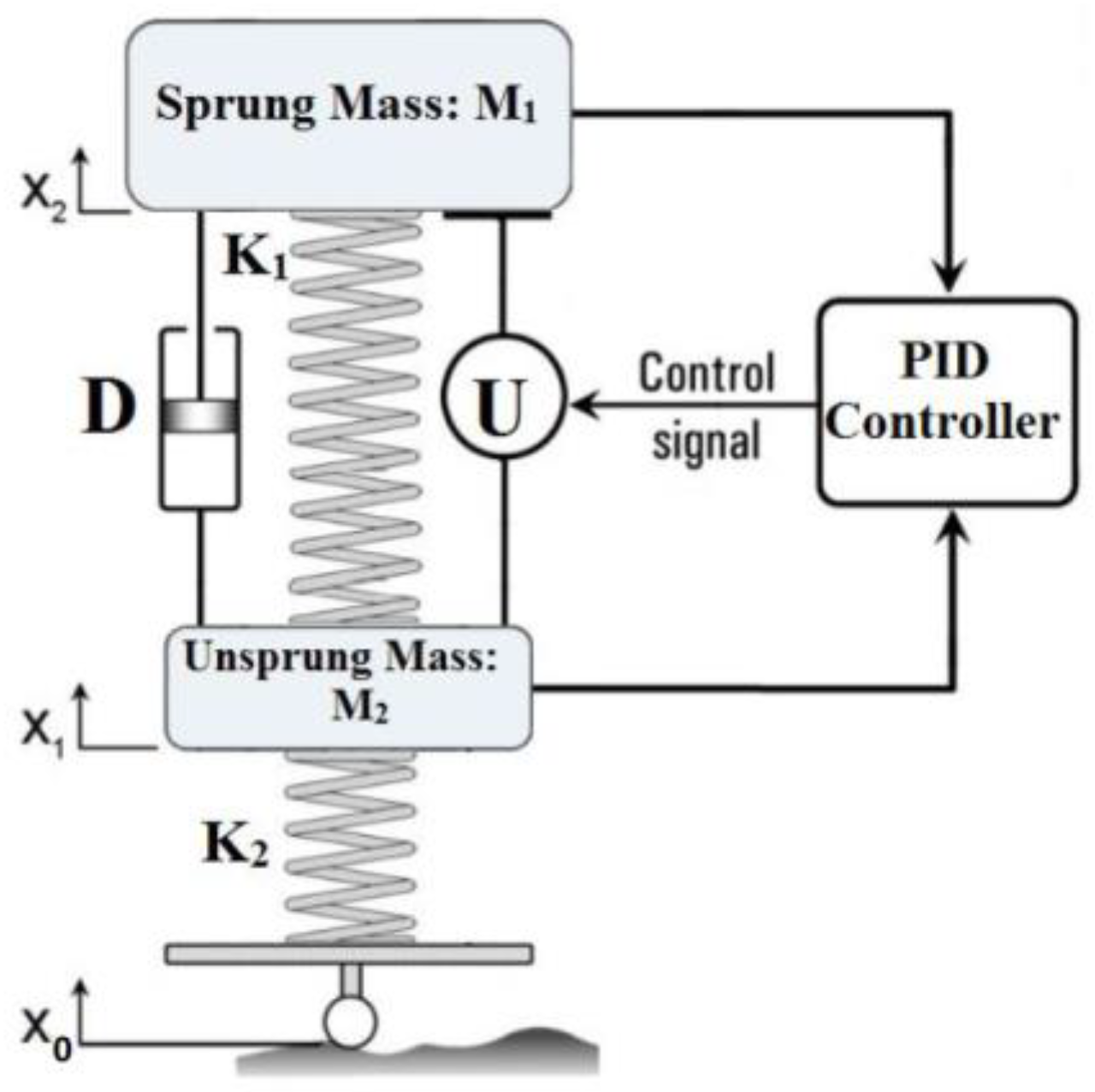
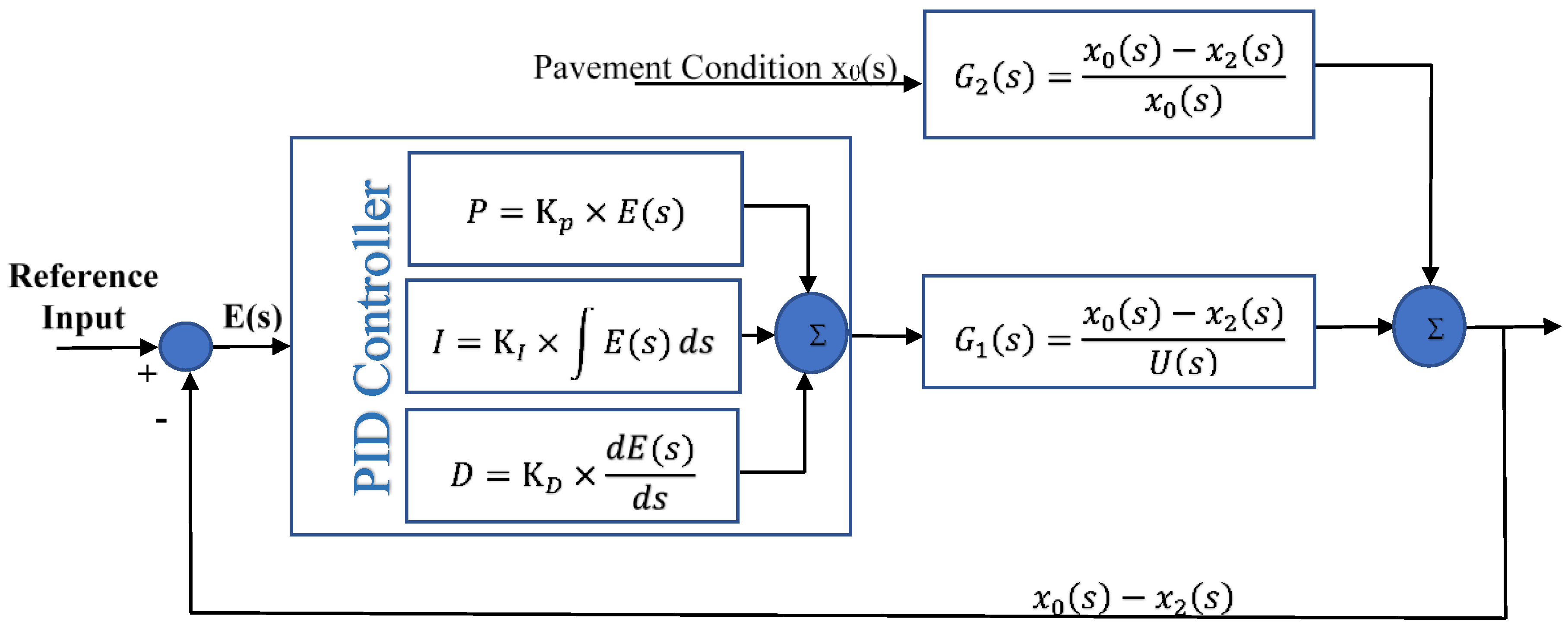

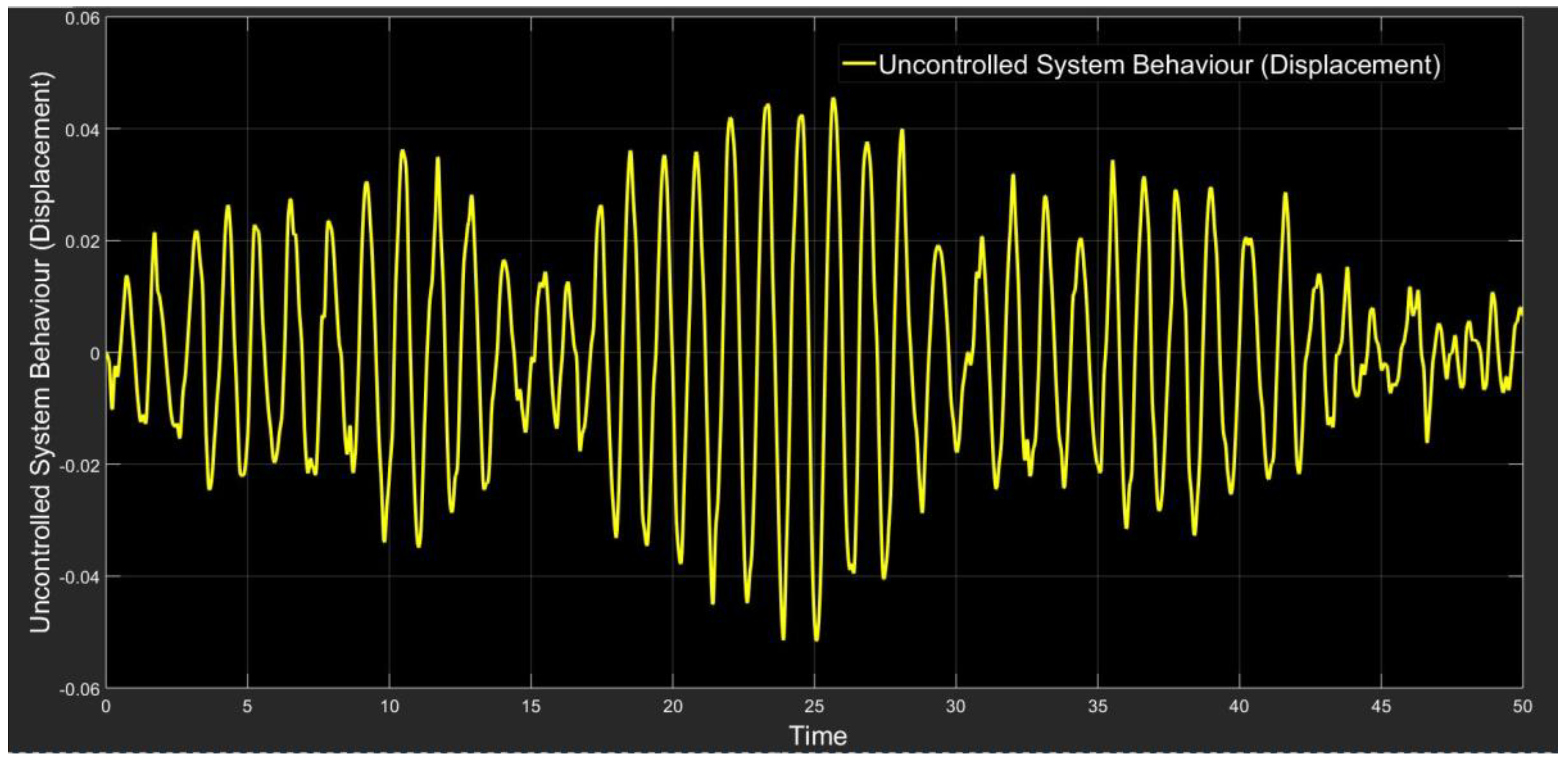
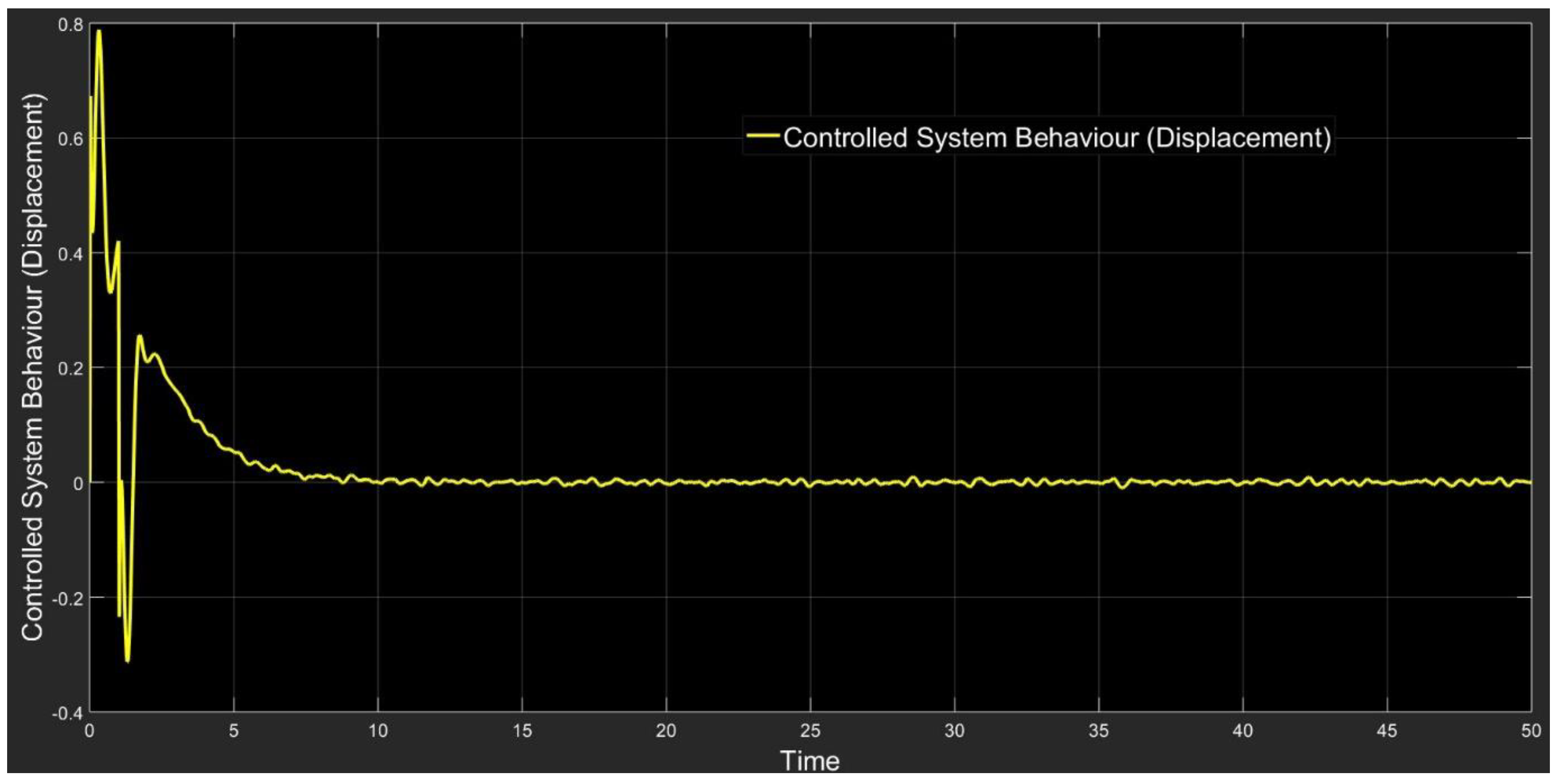


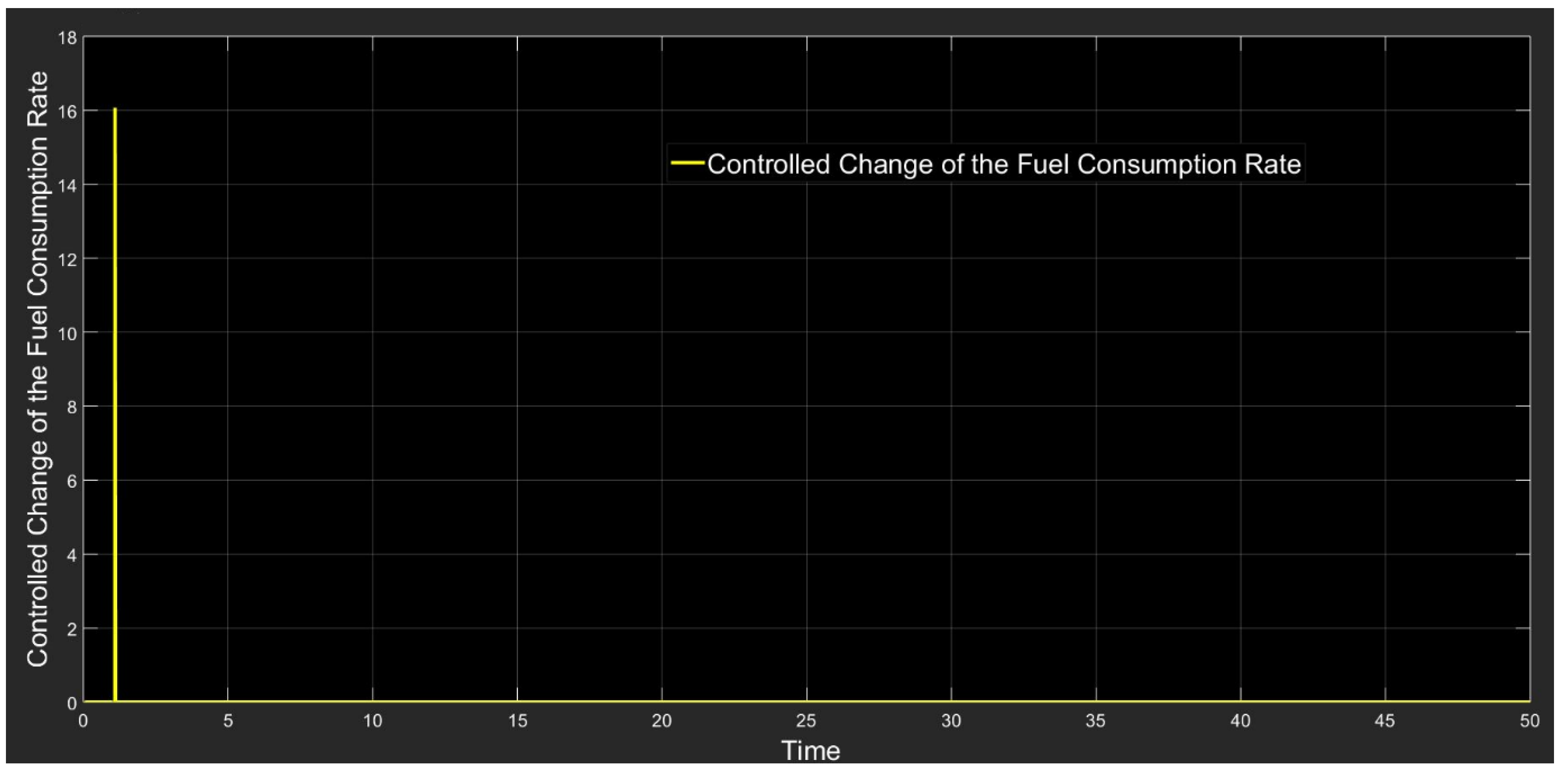
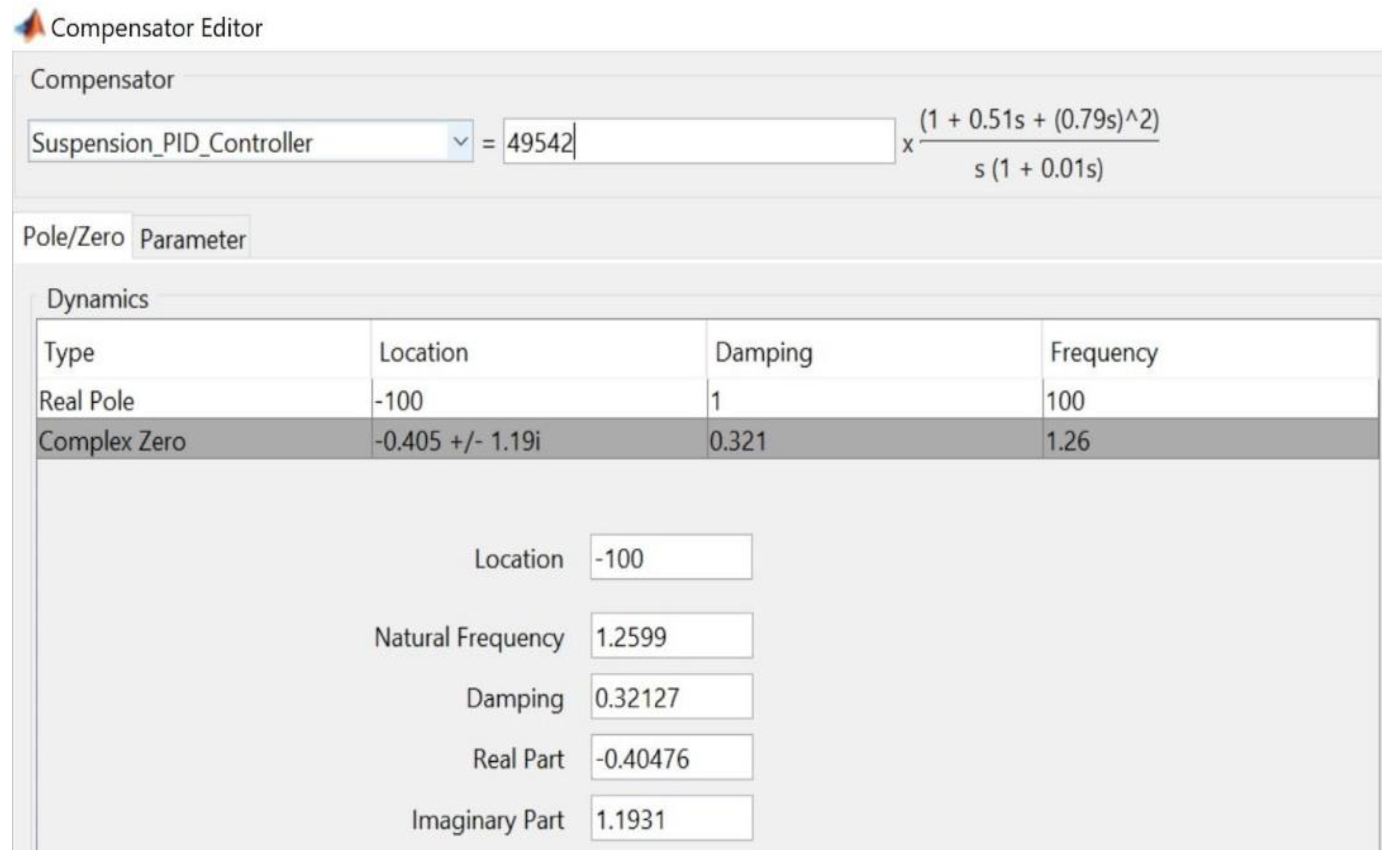
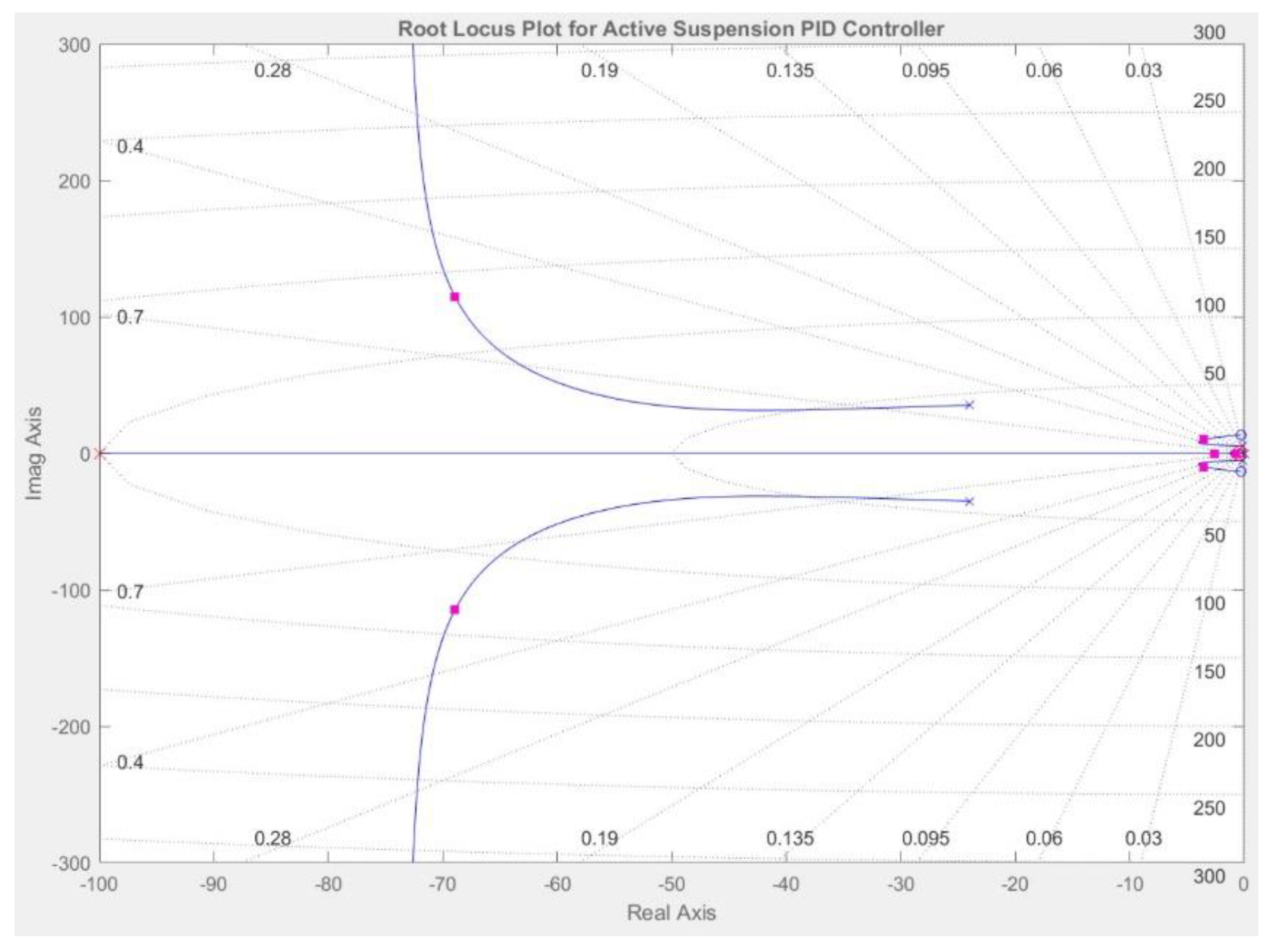
| Parameter | Stability | Steady State Error | Settling Time | Overshoot | Rise Time |
|---|---|---|---|---|---|
 KP KP | Degrade | Decrease | Small Change | Increase | Decrease |
 KI KI | Degrade | Eliminate | Increase | Increase | Decrease |
 KD KD | Improve For small KD | No effect in theory | Decrease | Decrease | Minor Change |
| Vehicle Model Parameters | Symbol | Numerical Value | Unit |
|---|---|---|---|
| Sprung Mass | M1 | 300 | kg |
| Unsprung Mass | M2 | 40 | kg |
| Suspension Stiffness | K1 | 15,000 | N/m |
| Tire Stiffness | K2 | 150,000 | N/m |
| Suspension Damping Coefficient | D | 1000 | Ns/m |
© 2018 by the author. Licensee MDPI, Basel, Switzerland. This article is an open access article distributed under the terms and conditions of the Creative Commons Attribution (CC BY) license (http://creativecommons.org/licenses/by/4.0/).
Share and Cite
Azizi, A. Computer-Based Analysis of the Stochastic Stability of Mechanical Structures Driven by White and Colored Noise. Sustainability 2018, 10, 3419. https://doi.org/10.3390/su10103419
Azizi A. Computer-Based Analysis of the Stochastic Stability of Mechanical Structures Driven by White and Colored Noise. Sustainability. 2018; 10(10):3419. https://doi.org/10.3390/su10103419
Chicago/Turabian StyleAzizi, Aydin. 2018. "Computer-Based Analysis of the Stochastic Stability of Mechanical Structures Driven by White and Colored Noise" Sustainability 10, no. 10: 3419. https://doi.org/10.3390/su10103419





